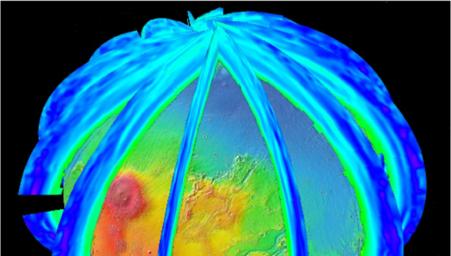Two Asteroids to Pass by Earth Wednesday

PASADENA, Calif. – Two asteroids, several meters in diameter and in unrelated orbits, will pass within the moon's distance of Earth on Wednesday, Sept. 8.
Both asteroids should be observable near closest approach to Earth with moderate-sized amateur telescopes. Neither of these objects has a chance of hitting Earth. A 10-meter-sized near-Earth asteroid from the undiscovered population of about 50 million would be expected to pass almost daily within a lunar distance, and one might strike Earth's atmosphere about every 10 years on average...
NASA's Magnetospheric Mission Passes Major Milestone
The universe is still an arcane place that scientists know very little about, but a new NASA Solar Terrestrial Probe mission is going to shed light on one especially mysterious event called magnetic reconnection. It occurs when magnetic lines of force cross, cancel, and reconnect releasing magnetic energy in the form of heat and charged-particle kinetic energy...
ادامه مطلب ...NASA Chat: Cheating the Weather to Improve On-Time Arrivals
We've all heard this announcement on an airplane before: "Uh, folks, we've got some weather around the airport right now. So I expect we'll be circling probably for the next half hour or so." Heather Arneson, a NASA Aeronautics Scholarship recipient and doctoral student at the University of Illinois, spent her summer at NASA working on ways to better control flows of aircraft into airspace impacted by weather...
ادامه مطلب ...NASA Tops Off Earl Research with Historic Global Hawk Flight

Missing Piece Inspires New Look at Mars Puzzle

September 03, 2010
PASADENA, Calif. -- Experiments prompted by a 2008 surprise from NASA's Phoenix Mars Lander suggest that soil examined by NASA's Viking Mars landers in 1976 may have contained carbon-based chemical building blocks of life...
Russian Firestorm: Finding a Fire Cloud from Space

Spitzer Finds a Flavorful Mix of Asteroids
New research from NASA's Spitzer Space Telescope reveals that asteroids somewhat near Earth, termed near-Earth objects, are a mixed bunch, with a surprisingly wide array of compositions. Like a piñata filled with everything from chocolates to fruity candies, these asteroids come in assorted colors and compositions. Some are dark and dull; others are shiny and bright. The Spitzer observations of 100 known near-Earth asteroids demonstrate that the objects’ diversity is greater than previously thought...
ادامه مطلب ...NASA Selects Science Investigations for Solar Probe Plus
WASHINGTON -- NASA has begun development of a mission to visit and study the sun closer than ever before. The unprecedented project, named Solar Probe Plus, is slated to launch no later than 2018.
The small car-sized spacecraft will plunge directly into the sun's atmosphere approximately four million miles from our star's surface. It will explore a region no other spacecraft ever has encountered. NASA has selected five science investigations that will unlock the sun's biggest mysteries...
NASA's Successful Ice Cloud and Land Elevation Mission Comes to

Hurricane Katrina: A NASA Satellite Video Retrospective
Alpha Magnetic Spectrometer Makes Last Stop on Earth

Tracing the Big Picture of Mars' Atmosphere
August 26, 2010
Kepler Discovers Multiple Planets Transiting a Single Star

The transit signatures of two distinct Saturn-sized planets were seen in the data for a sun-like star designated "Kepler-9." The planets were named Kepler-9b and 9c. The discovery incorporates seven months of observations of more than 156,000 stars as part of an ongoing search for Earth-sized planets outside our solar system. The findings will be published in Thursday's issue of the journal Science...
The Mutating Mars Hoax
For the seventh year in a row, the Mars Hoax is infecting email boxes around the world. Passed from one reader to another, the message states that on August 27th Mars will approach Earth and swell to the size of a full Moon. "NO ONE ALIVE TODAY WILL EVER SEE THIS AGAIN," the email declares--always in caps.
News flash: It's not true.
Pulverized Planet Dust May Lie Around Double Stars
PASADENA, Calif. -- Tight double-star systems might not be the best places for life to spring up, according to a new study using data from NASA's Spitzer Space Telescope. The infrared observatory spotted a surprisingly large amount of dust around three mature, close-orbiting star pairs. Where did the dust come from? Astronomers say it might be the aftermath of tremendous planetary collisions.






